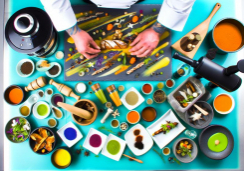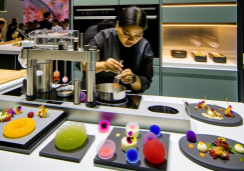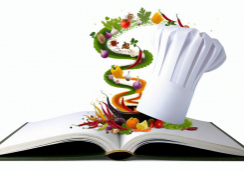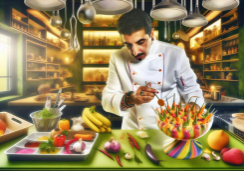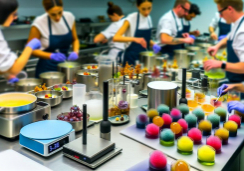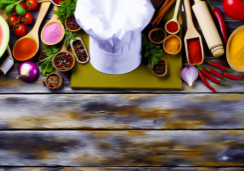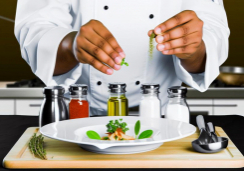5 Best Tips for Crafting Gluten-Free Baking Recipes
Congratulations, you've decided to tackle the world of gluten-free baking! Every cup of flour is a potential adventure and traditional recipes often seem like ancient, indecipherable texts.
As you embark on this journey, don't let the lack of gluten get your dough down. You'll need to understand the nuances of gluten-free flours, the importance of moisture balance, and the tricks to perfect leavening. These factors are crucial to ensure your baked goods don't turn into culinary bricks.
You're about to discover how to enhance flavors that can otherwise be as bland as cardboard. Additionally, you'll learn how to navigate the treacherous waters of ingredient substitutions without sacrificing texture or taste.
So, strap on your apron and prepare to transform your kitchen into a gluten-free laboratory! Delicious experiments await your expertise.
Mastering Gluten-Free Flours
To master gluten-free baking, begin by experimenting with various flour blends to discover the flavors and textures that best suit your palate. Mastering gluten-free calls for a dive into the world of different types of baking flour beyond the usual wheat. Your gluten-free recipe treasure chest should include a mix of base flours like rice or sorghum, starches such as tapioca or potato, enriching nut flours, and nutrient-packed ancient grains.
Delve into gluten-free cooking with the knowledge that each flour brings its own unique profile. Mix and match to achieve the perfect balance for your gluten-free baked goods. But remember, the structure of baked goods without gluten can be tricky. That's where xanthan gum or guar gum step in as your culinary sidekicks. These additives mimic gluten's elasticity and binding properties, giving your creations the cohesiveness they crave.
If you're not up for playing kitchen alchemist, pre-made gluten-free flour blends are your go-to. They offer convenience with consistent results, ensuring that your gluten-free delights charm your taste buds every time. Whether you're crafting your blend or using a store-bought one, refining your choice of flour is key to gluten-free baking that's as delightful as its glutenous counterpart.
Balancing Moisture Content
While mastering gluten-free flours is crucial, it's equally important to nail the moisture balance in your baked goods to ensure they don't turn out dry or crumbly. Your gluten-free diet shouldn't mean sacrificing the indulgence of moist and tender gluten-free desserts.
To conquer the moisture challenge, consider these baking tips:
- *Incorporate moisture-rich ingredients*:
- Use pureed fruit, sour cream, or yogurt to add both moisture and flavor.
- Opt for brown sugar over white to lend extra moisture, courtesy of its molasses content.
- *Adjust liquids when adding sweeteners*:
- When using honey or agave, reduce other liquids slightly to maintain the right consistency without making your batter too wet.
Adding extra eggs or a bit more oil can also do the trick for boosting moisture content. But remember, balance is key; too much can lead to a greasy or heavy texture.
Lastly, don't be afraid to experiment with your gluten-free flour blend. Adding a portion of brown rice flour might provide the structure your recipe needs while retaining moisture. And if your batter seems too thick, a splash of hot water can help adjust it to the perfect consistency. Keep trying different combinations to find the ideal moisture balance for your gluten-free baking triumphs.
Perfecting Leavening Ratios
Achieving the perfect rise in your gluten-free baked goods hinges on nailing the correct leavening ratios, which often differ from their gluten-containing counterparts. Start by using 2 teaspoons of baking powder per cup of gluten-free flour. This is your secret weapon for that much-desired lift and airy crumb. Remember, gluten-free flours lack the proteins that trap air and create structure, so your leavening agents are doing double duty.
If you're going for a tangy kick, swap out baking powder for baking soda paired with buttermilk. You'll need to balance the pH by adding 1-1/8 teaspoon of cream of tartar for each 1/2 teaspoon of baking soda used. This tweak isn't just about flavor—it's chemistry at work, ensuring your Gluten Free recipes rise to the occasion.
Always dissolve these leaveners in liquid before introducing them to your gluten-free dough. This step ensures an even distribution, preventing the dreaded dense spots and contributing to a uniformly chewy texture.
When perfecting your gluten-free blend at high altitudes, remember to decrease the liquid slightly and consider tweaking the oven temperature or baking time. Each adjustment is a step toward Gluten Free perfection. Don't hesitate to add a tablespoon more flour or adjust leavening to achieve the best results.
Enhancing Flavor Profiles
Embark on a flavor adventure by infusing your gluten-free baked goods with a symphony of spices and extracts to elevate their taste profile. Since gluten-free flours often have distinct flavors, enhancing the overall taste is crucial. Don't just swap out flours; become a maestro of taste by artfully combining ingredients that complement each other.
- Experiment with Flavor Combinations:
- Add a dash of cinnamon or nutmeg to almond flours for a warm, inviting aroma.
- Mix lemon zest into quinoa flour recipes for a citrusy zing.
- Mask Unfamiliar Flavors:
- Incorporate brown rice flour with a hint of vanilla to soften its earthy notes.
- Balance out any bitterness with a spoonful of Maple syrup or a dollop of sour cream.
Navigating Ingredient Substitutions
After mastering the art of flavor enhancement, it's essential to tackle the challenge of substituting ingredients in gluten-free baking without compromising texture or taste. When you replace all-purpose flour in traditional recipes, understanding the role of the original component is vital. Gluten-free flours, like almond, coconut, or sorghum, offer a spectrum of flavors and textures, so you'll need to experiment to find the perfect blend for your needs.
Keep in mind, gluten-free baking often requires adjustments in moisture. If you're ditching eggs for flaxseed or chia seeds due to celiac disease or preference, you'll also have to tweak the liquid content to achieve the right consistency. Make sure to check labels as some products may still contain gluten.
Here's a tip: for every cup of gluten-free flour, consider incorporating a binder like xanthan gum or guar gum to mimic gluten's structural properties. These gums are your allies, providing the elasticity and stickiness that gluten typically offers.
Can I Use the Tips for Crafting Gluten-Free Baking Recipes in the 11 Gluten-Free Baking Recipes provided?
Absolutely, the tips for crafting gluten-free baking recipes can enhance the 11 gluten-free baking recipes provided, transforming these guidelines into personalized glutenfree baking recipes homemade delights. By using these specialized strategies, you’ll ensure each creation satisfies your cravings for scrumptious, celiac-safe treats.
Conclusion
Now that you're equipped with these top tips, you're ready to bake gluten-free wonders with confidence. Remember to tweak baking times and temps, play with flavors, store ingredients right, adjust leavening, and balance moisture masterfully.
Get creative and enjoy the process—your kitchen's about to be filled with the aroma of success.
Happy baking!

